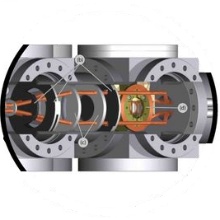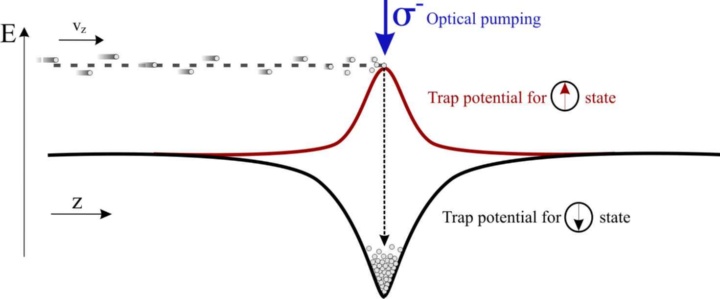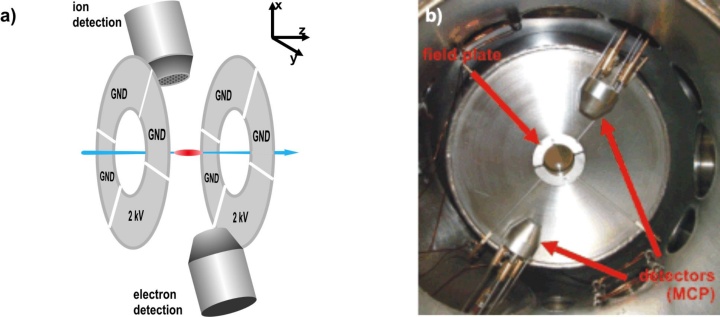Giant Rydberg Atoms in Ultracold Quantum Gases
Our experiments focused on the study of single Rydberg atoms embedded in an ultracold quantum gas at temperatures in the nanokelvin regime. Our ability to control such Rydberg impurities with principal quantum numbers up to n~200 allowed us to investigate situations where the size of the Rydberg atom by far extends the typical distance between the trapped atoms. This provided ways to investigate the interaction of the Rydberg electron with single, few, or many neutral perturbers residing within the electronic orbital. The quantum mechanical scattering process describing this interaction lead to a new molecular bond and the formation of giant so-called ultralong-range Rydberg molecules.
For many perturbers within the Rydberg orbit, which is realized when exciting the Rydberg state in a Bose-Einstein condensate, the contribution of higher-order partial waves in the electron-neutral scattering process could be studied. Specifically, a detailed modelling of the excitation lineshape, which is strongly shifted and broadened by the interaction with the condensate, revealed signatures of an electron-atom p-wave scattering resonance. Moreover, the lifetime of the Rydberg electron in the dense medium is determined by chemical reactions on micrometer length scales and microsecond time scales, leading to molecular ion formation and collision-induced changes of the electron’s orbital angular momentum. In this regime, we pursued to observe the backaction of the Rydberg electron on the condensate density distribution, a mechanism that may lead to a microscopy tool for electronic orbitals.
We focused on the interaction of the positively charged ionic Rydberg core with the Bose-Einstein condensate. This ion-atom interaction is much weaker than the electron-atom interaction and typically fully disguised by the latter. However, the contribution of the electron could be largely reduced once its orbit exceeds the typical size of the atomic sample. At the same time, the presence of the electron serves as a protective Faraday shield for the ion from detrimental electric stray fields. We demonstrated this regime using a micron-sized optical tweezer trap and observe evidence for ion-atom interaction. These experiments may lead to a new way for studying ionic impurities in a BEC at temperatures where quantum effects in the scattering process start to play a role, with prospects for the exploration of associated polaron physics.
| [1] |
T. Dieterle, M. Berngruber, C. Hölzl, R. Löw, K. Jachymski, T. Pfau, F. Meinert Transport of a Single Cold Ion Immersed in a Bose-Einstein Condensate Phys. Rev. Lett. 126, 033401 (2021) |
| [2] |
M. J. Mark, S. Flannigan, F. Meinert, J. P. DIncao, A. J. Daley, H.-C. Nägerl Interplay between coherent and dissipative dynamics of bosonic doublons in an optical lattice Phys. Rev. Research 2, 043050 (2020) |
| [3] |
K. Jachymski, F. Meinert Vibrational Quenching of Weakly Bound Cold Molecular Ions Immersed in Their Parent Gas applied sciences 10, 2371 (2020) |
| [4] |
M. Deiß, S. Haze, J. Wolf, L. Wang, F. Meinert, C. Fey, F. Hummel, P. Schmelcher, J. Hecker Denschlag Observation of spin-orbit-dependent electron scattering using long-range Rydberg molecules Phys. Rev. Research 2, 013047 (2020) |
| 5] |
T. Dieterle, M. Berngruber, C. Hölzl, R. Löw, K. Jachymski, T. Pfau, F. Meinert Inelastic collision dynamics of a single cold ion immersed in a Bose-Einstein condensate Phys. Rev. A 102, 041301 (2020). |
| [6] |
R. Mukherjee, F. Sauvage, H. Xie, R. Loew, F. Mintert Preparation of ordered states in ultra-cold gases using Bayesian optimization New Journal of Physics 22, 075001 (2020) |
| [7] |
F. Engel, T. Dieterle, F. Hummel, C. Fey, P. Schmelcher, R. Löw, T. Pfau, F. Meinert Precision Spectroscopy of Negative-Ion Resonances in Ultralong-Range Rydberg Molecules Phys. Rev. Lett. 123, 073003 (2019) |
| [8] |
M. J. Mark, F. Meinert, K. Lauber, H.-C. Nägerl Mott-insulator-aided detection of ultra-narrow Feshbach resonances SciPost Phys. 5, 055 (2018) |
| [9] |
K. S. Kleinbach, F. Engel, T. Dieterle, R. Löw, T. Pfau, F. Meinert Ionic Impurity in a Bose-Einstein Condensate at Submicrokelvin Temperatures |
| [10] |
F. Engel, T. Dieterle, T. Schmid, C. Tomschitz, C. Veit, N. Zuber, R. Löw, T. Pfau, F. Meinert Observation of Rydberg Blockade Induced by a Single Ion Phys. Rev. Lett. 121, 193401 (2018) |
| [11] |
F. Meinert Riesenmoleküle am absoluten Nullpunkt Phys. Unserer Zeit 48, 236–242 (2017) |
| [12] |
K. Jachymski, F. Meinert, H. Veksler, P. S. Julienne, S. Fishman Ultracold atoms in quasi-1D traps: a step beyond the Lieb-Liniger model Phys. Rev. A 95, 052703 (2017) |
| [13] |
K. Kleinbach, F. Meinert, F. Engel, W. Kwon, R. Löw, T. Pfau, G. Raithel Photoassociation of Trilobite Rydberg Molecules via Resonant Spin-Orbit Coupling Phys. Rev. Lett. 118, 223001 (2017) |
| [14] |
F. Böttcher, A. Gaj, K. M. Westphal, M. Schlagmüller, K. S. Kleinbach, R. Löw, T. C. Liebisch, T. Pfau, S. Hofferberth Observation of mixed singlet-triplet Rb2 Rydberg molecules Phys. Rev. A 93, 032512 (2016) |
| [15] |
M. Schlagmüller, T. C. Liebisch, F. Engel, K. S. Kleinbach, F. Böttcher, U. Hermann, K. M. Westphal, A. Gaj, R. Löw, S. Hofferberth, T. Pfau, J. Pérez-Ríos, C. H. Greene Ultracold Chemical Reactions of a Single Rydberg Atom in a Dense Gas Phys. Rev. X 6, 031020 (2016) |
| [16] |
T. C. Liebisch, M. Schlagmüller, F. Engel, H. Nguyen, J. Balewski, G. Lochead, F. Böttcher, K. M. Westphal, K. S. Kleinbach, T. Schmid, A. Gaj, R. Löw, S. Hofferberth, T. Pfau, J. Pérez-Ríos, C. H. Greene Controlling Rydberg atom excitations in dense background gases J. Phys. B: At. Mol. Opt. Phys. 49, 182001 (2016) |
| [17] |
T. Karpiuk, M. Brewczyk, K. Rzążewski, A. Gaj, J. B. Balewski, A. T. Krupp, M. Schlagmüller, R. Löw, S. Hofferberth, T. Pfau Imaging single Rydberg electrons in a Bose–Einstein condensate New Journal of Physics 17, 053046 (2015) |
Novel sources of ultra cold matter
We studied a new approach to reach quantum degeneracy for situations when standard laser cooling mechanisms are not applicable, e.g. due to the lack of a closed cycling transition. An optical dipole trap (ODT) is continously loaded from a guided atomic beam with a mechanism that can be compared to a diode for atoms. An ODT is therefore placed within an atomic beam. A state dependent potential barrier superimposed to the trap removes the directed kinetic energy from the atoms, while they are traveling through the ODT's focus. This dissipative mechanism is in principle a single photon process, and not depending on a closed cycling transition. Loading the trap until it reaches the collisionally dense regime then allows further cooling by evaporation.
With this method, we managed to produce a BEC with chromium atoms within less than 5s. While we did not use laser cooling to generate our beam of chromium atoms, there are methods to generate intense beams with molecules that have recently been established and which are not based on cycling transitions.
| [1] | A. Griesmaier, J. Werner, S. Hensler, J. Stuhler, and T. Pfau "Bose-Einstein condensation of chromium" Phys. Rev. Lett. 94, 160401 (2005) |
| [2] | A. Greiner, J. Sebastian, P. Rehme, A. Aghajani-Talesh, A. Griesmaier, and T. Pfau "Loading chromium atoms in a magnetic guide" J. Phys. B, 40 F77 (2007) |
| [3] | A. Griesmaier, A. Aghajani-Talesh, M. Falkenau, J. Sebastian, A. Greiner, and T. Pfau "A high flux of ultra-cold chromium atoms in a magnetic guide" J. Phys. B: At. Mol. Opt. Phys. 42 145306 (2009) |
| [4] | A. Aghajani-Talesh, M. Falkenau, A. Griesmaier and T. Pfau "A proposal for continuous loading of an optical dipole trap with magnetically guided ultra cold atoms" J. Phys. B: At. Mol. Opt. Phys. 42 245302 (2009) |
| [5] | A. Aghajani-Talesh, M. Falkenau, V.V. Volchkov, L.E. Trafford, T. Pfau, and A. Griesmaier "Laser cooling of a magnetically guided ultra cold atom beam" New J. Phys. 12 065018 (2010) |
| [6] | M. Falkenau, V. V. Volchkov, J. Rührig, A. Griesmaier, and T. Pfau "Continuous Loading of a Conservative Trap from an Atomic Beam" Phys. Rev. Lett. 106, 163002 (2011) |
| [7] | M. Falkenau, V. V. Volchkov, J. Rührig, H. Gorniaczyk, and A. Griesmaier "Evaporation-limited loading of an atomic trap" Phys. Rev. A 85, 023412 (2012) |
| [8] | V. V. Volchkov, J. Rührig, T. Pfau, and A. Griesmaier "Sisyphus cooling in a continuously loaded trap" New J. Phys. 15 093012 (2013) |
| [9] | V. V. Volchkov, J. Rührig, T. Pfau, and A. Griesmaier "Efficient demagnetization cooling of atoms and its limits" Phys. Rev. A 89, 043417 (2014) |
| [10] | J. Rührig, T. Bäuerle, A. Griesmaier, and T. Pfau "High efficiency demagnetization cooling by suppression of light-assisted collisions" Opt. Express 23, 5596-5606 (2015) [Focus Issue: Optical Cooling and Trapping] |
| [11] | J. Rührig, T. Bäuerle, P. S. Julienne, E. Tiesinga, and T. Pfau "Photoassociation of spin polarized Chromium" Phys. Rev. A 93, 021406 (2016) |
Strongly interacting Rydberg gases
In our first generation Rubidium Rydberg experiment, we have started our long-standing endeavor to probe and control giant Rydberg atoms in an ultracold atomic gas. The apparatus used a single chamber approach, where MOT and magnetic trap are located at the same spot. The MOT was loaded from a Zeeman slower, followed by a magnetic cloverleaf trap, in which BECs containing ~105 atoms have been produced. The magnetic trap is located at the center of 8 electric field plates (see figure) which can produce strong electric fields for tuning and ionization of the Rydberg atoms.
Our experiments started with detailed studies of interactions between Rydberg atoms (dipole-dipole and van der Waals interaction), tuning of interactions via Förster resonances, and the demonstration of the first excitation of Rydberg atoms in a Bose-Einstein condensate. The excitation of Rydberg atoms in a dense an ultracold atomic ensemble lead to the experimental discovery of a new type of molecular bond between Rydberg and ground state atoms, forming an ultralong-range Rydberg molecule. We have investigated the nature of this binding mechanism in detail, demonstrated coherent control of the long-range dimers, and studied the transition from few-body bound states to many-body density shifts.
| [1] | A. Grabowski, R. Heidemann, R. Löw, J. Stuhler, and T. Pfau "High Resolution Rydberg Spectroscopy of ultracold Rubidium Atoms" Fortschr. Phys. 54, 765 (2006) |
| [2] | R. Heidemann, U. Raitzsch, V. Bendkowsky, B. Butscher, R. Löw, L. Santos, and T. Pfau "Evidence for coherent collective Rydberg excitation in the strong blockade regime" Phys. Rev. Lett. 99, 163601 (2007) |
| [3] | U. Raitzsch, V. Bendkowsky, R. Heidemann, B. Butscher, R. Löw, and T. Pfau "An echo experiment in a strongly interacting Rydberg gas" Phys. Rev. Lett. 100 , 013002 (2008) |
| [4] | R. Heidemann, U. Raitzsch, V. Bendkowsky, B. Butscher, R. Löw, and T. Pfau "Rydberg excitation of Bose-Einstein condensates" Phys. Rev. Lett. 100, 033601 (2008) |
| [5] | H. Weimer, R. Löw, T. Pfau, H. P. Büchler "Quantum critical behavior in strongly interacting Rydberg gases" Phys. Rev. Lett. 101, 250601 (2008) |
| [6] | V. Bendkowsky, B. Butscher, J. Nipper, J. P. Shaffer, R. Löw, and T. Pfau "Observation of ultralong-range Rydberg molecules" Nature 458, 1005-1008 (2009) |
| [7] | V. Bendkowsky, B. Butscher, J. Nipper, J. Balewski, J. P. Shaffer, R. Löw, T. Pfau, W. Li, J. Stanojevic, T. Pohl, and J. M. Rost "Rydberg trimers and excited dimers bound by internal quantum reflection" Phys. Rev. Lett. 105, 163201 (2010) |
| [8] | B. Butscher, J. Nipper, J. B. Balewski, L. Kukota, V. Bendkowsky, R. Löw, and T. Pfau "Atom-molecule coherence for ultralong range Rydberg dimers" Nature Physics 6, 970–974 (2010) |
| [9] | B. Butscher, V. Bendkowsky, J. Nipper, J. B. Balewski, L. Kukota, R. Löw, T. Pfau W. Li, T. Pohl, and J. M. Rost "Lifetimes of ultralong-range Rydberg molecules in vibrational ground and excited states" J. Phys. B: At. Mol. Opt. Phys. 44, 184004 (2011) |
| [10] | W. Li, T. Pohl, J. M. Rost, Seth T. Rittenhouse, H. R. Sadeghpour, J. Nipper, B. Butscher, J. B. Balewski, V. Bendkowsky, R. Löw, and T. Pfau "A Homonuclear Molecule with a Permanent Electric Dipole Moment" Science 334, 1110 (2011) |
| [11] | J. Nipper, J. B. Balewski, A. T. Krupp, B. Butscher, R. Löw, and T. Pfau "Highly Resolved Measurements of Stark-Tuned Förster Resonances between Rydberg Atoms" Phys. Rev. Lett. 108, 113001 (2012) |
| [12] | R. Löw, H. Weimer, J. Nipper, J. B. Balewski, B. Butscher, H. P. Büchler, and T. Pfau "An experimental and theoretical guide to strongly interacting Rydberg gases" J. Phys. B: At. Mol. Opt. Phys. 45, 113001 (2012) |
| [13] | J. Nipper, J. B. Balewski, A. T. Krupp, S. Hofferberth, R. Löw, and T. Pfau "Atomic Pair-State Interferometer: Controlling and Measuring an Interaction-Induced Phase Shift in Rydberg-Atom Pairs" Phys. Rev. X 2, 031011 (2012) |
| [14] | J. B. Balewski, A. T. Krupp, A. Gaj, D. Peter, H. P. Büchler, R. Löw, S. Hofferberth, and T. Pfau "Coupling a single electron to a Bose-Einstein condensate" Nature 502, 664 (2013) |
| [15] | J.B. Balewski, A.T. Krupp, A. Gaj, S. Hofferberth, R. Löw, and T. Pfau "Rydberg dressing: Understanding of collective many-body effects and implications for experiments" New J. Phys. 16 063012 (2014) |
| [16] | A.T. Krupp, A. Gaj, J.B. Balewski, P. Ilzhöfer, S. Hofferberth, R. Löw, T. Pfau, M. Kurz, and P. Schmelcher "Alignment of D-state Rydberg molecules" Phys. Rev. Lett. 112, 143008 (2014) |
| [17] | T. Karpiuk, M. Brewczyk, K. Rzążewski, A. Gaj, J. B. Balewski, A. T. Krupp, M. Schlagmüller, R. Löw, S. Hofferberth, and T. Pfau "Detecting and imaging single Rydberg electrons in a Bose-Einstein condensate" New Journal of Physics, 17, 053046 (2015) |
| [18] | A. Gaj, A. T. Krupp, J. B. Balewski, R. Löw, S. Hofferberth, and T. Pfau "From molecular spectra to a density shift in dense Rydberg gases" Nature Comm. 5, 4546 (2014) |
| [19] | K. R. A. Hazzard, M. van d. Worm, M. Foss-Feig, S. R. Manmana, E. D. Torre, T. Pfau, M. Kastner, A. M. Rey "Quantum correlations and entanglement in far-from-equilibrium spin systems" Phys. Rev. A 90, 063622 (2014) |
| [20] | A. Gaj, A. T. Krupp, P. Ilzhöfer, R. Löw, S. Hofferberth, T. Pfau "Hybridization of Rydberg electron orbitals by molecule formation" Phys. Rev. Lett., 115 , 023001 (2015) |
Rydberg Quantum Optics
The Rydberg Quantum Optics Group led by Sebastian Hofferberth moved to Syddansk University (Odense, Denmark). The website of Sebastian's group can be found here.
Contact

5. Physikalisches Institut
Administration




